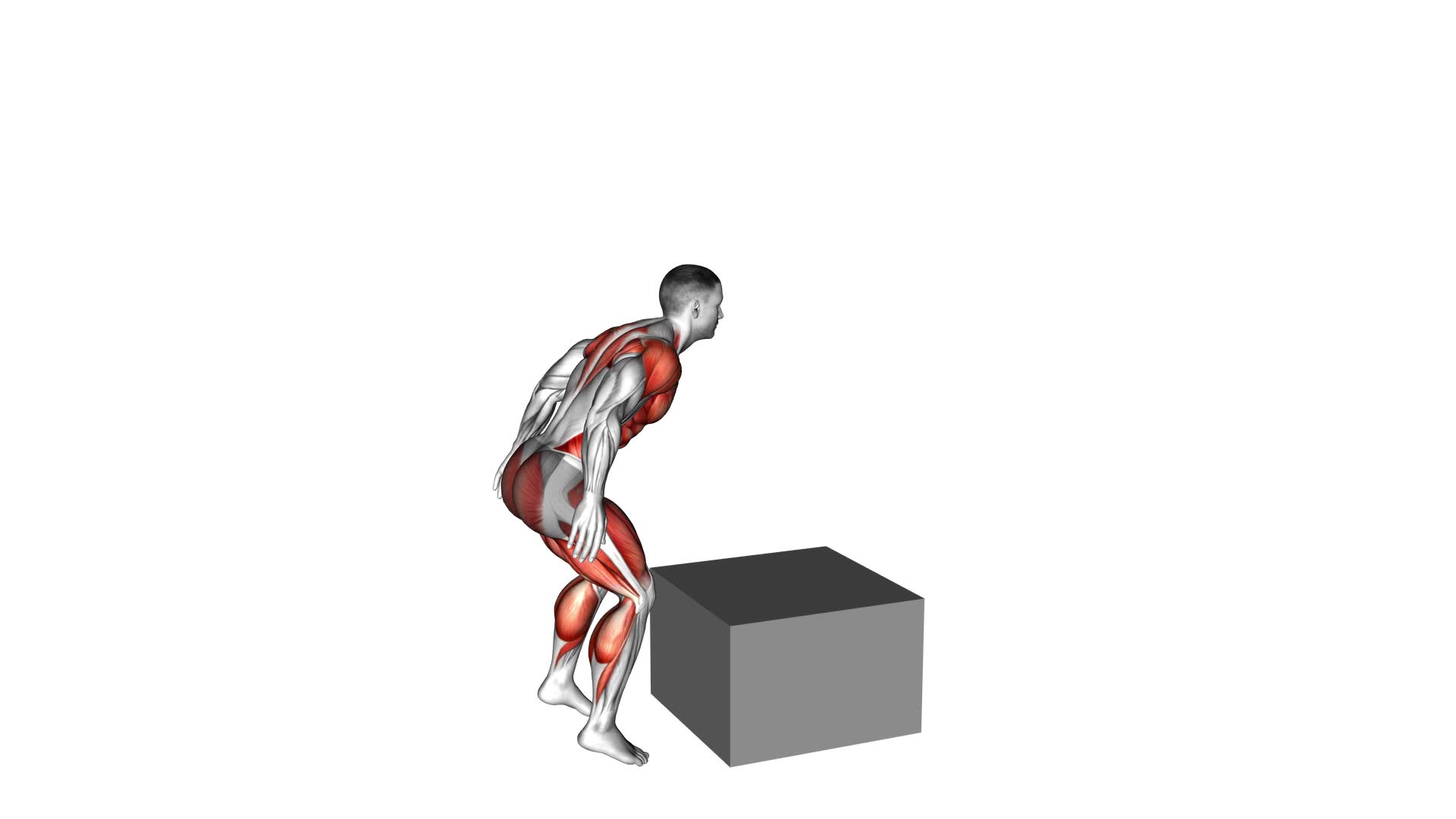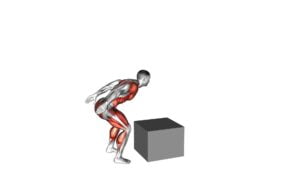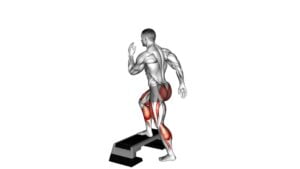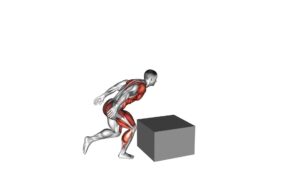Jump Box (male) – Video Exercise Guide & Tips

Are you ready to take your workouts to new heights?
Watch This Exercise Video
Look no further than the jump box! This video exercise guide is designed specifically for men like you, providing step-by-step instructions and tips to maximize your workout.
Whether you're a beginner or a seasoned pro, this guide has something for everyone. Get ready to elevate your fitness routine and achieve your goals with the jump box.
Let's jump into it!
Key Takeaways
- Jump box exercises engage multiple muscle groups simultaneously.
- Jump box exercises improve power, speed, and agility.
- Jump box exercises train muscles to absorb and generate force efficiently.
- Jump box exercises improve cardiovascular endurance.
Benefits of Jump Box Exercises
To experience the full range of benefits from jump box exercises, you need to consistently incorporate them into your workout routine. Plyometric training, which involves explosive movements, can greatly enhance your overall fitness and athletic performance. Jump box exercises are a key component of plyometric training, as they involve jumping onto and off of a box at various heights. These exercises target multiple muscle groups simultaneously, making them highly effective for muscle strengthening.
Jump box exercises engage your lower body muscles, including your quadriceps, hamstrings, glutes, and calves. The explosive nature of these exercises helps to improve your power, speed, and agility. By repeatedly jumping onto the box and landing softly, you train your muscles to absorb and generate force efficiently, reducing the risk of injury and enhancing your athletic performance.
Not only do jump box exercises build strength, but they also improve your cardiovascular endurance. The high-intensity nature of these exercises increases your heart rate, improving your stamina and overall cardiovascular health.
To reap the full benefits of jump box exercises, it's crucial to focus on proper technique and form. This will ensure that you engage the correct muscles and minimize the risk of injury.
Proper Technique and Form
Mastering the proper technique and form of jump box exercises is essential for maximizing your results and minimizing the risk of injury. To ensure you're performing jump box exercises correctly, it's important to avoid some common mistakes that can lead to injuries.
One common mistake is using improper landing technique. When jumping onto the box, make sure to land softly with your knees bent and your weight distributed evenly. Avoid landing with your legs straight, as this can put excessive stress on your joints and increase the risk of injury.
Another mistake to avoid is jumping too high or too fast. While it may be tempting to jump as high as possible, it's important to start with a height that's comfortable and gradually increase it as your strength and technique improve. Additionally, jumping too fast can compromise your form and increase the risk of tripping or losing balance.
Injury prevention should be a top priority when performing jump box exercises. Always warm up before your workout, and listen to your body. If you experience any pain or discomfort, stop and assess your form. It's better to take a break and correct your technique than to push through and risk injury.
Beginner-Friendly Jump Box Exercises
If you're a beginner, start with simple jump box exercises to build strength and confidence. The jump box is a versatile tool that can be modified to suit your fitness level. To ensure your safety, there are a few precautions you should take.
First, make sure the jump box is stable and secure before using it. Double-check that it can support your weight and won't wobble during your exercises.
Second, start with a lower height to get comfortable with the movement. You can gradually increase the height as you progress.
Third, always land with soft knees to absorb the impact and protect your joints.
Lastly, listen to your body and take breaks when needed. Push yourself, but don't overdo it.
Some beginner-friendly jump box exercises include step-ups, box squats, and lateral step-overs. These exercises focus on building lower body strength and improving coordination.
Step-ups involve stepping onto the box with one foot and then bringing the other foot up.
Box squats involve sitting back onto the box and then standing up.
Lateral step-overs require you to step sideways onto the box and then back down.
Advanced Jump Box Exercises
Now let's take your jump box training to the next level with advanced exercises that will challenge your strength and coordination. Plyometric training is the key to increasing your vertical jump and taking your athleticism to new heights.
One advanced exercise that you can incorporate into your jump box routine is the Depth Jump. Start by standing on top of the box, then step off and quickly explode back up into a jump as soon as your feet touch the ground. This exercise helps to improve your reactive strength and power, which are essential for a higher vertical jump.
Another challenging exercise is the Box Jump to Single-Leg Landing. Begin by performing a box jump onto the top of the box, then immediately transition into a single-leg landing on the opposite side. This exercise helps to improve your balance and stability, as well as your jumping ability.
To further enhance your plyometric training, try incorporating lateral jumps onto and off the box. This exercise targets your lateral power and agility, which are important for sports that require quick changes in direction.
Tips for Maximizing Your Jump Box Workout
To maximize your jump box workout, try incorporating these tips into your routine.
First and foremost, it's important to be aware of common mistakes that can hinder your progress. One common mistake is using improper form, such as not fully extending your hips and knees when jumping onto the box. This can put unnecessary strain on your joints and increase the risk of injury. Another mistake is starting with a box that's too high for your current fitness level. It's better to start with a lower box and gradually increase the height as you become more comfortable and confident.
In addition to avoiding common mistakes, it's crucial to take safety precautions during your jump box workout. Make sure the surface you're jumping on is stable and secure. Avoid slippery or uneven surfaces that could cause you to lose your balance. It's also important to wear appropriate footwear with good grip to prevent slipping.
Lastly, listen to your body and know your limits. If you feel any pain or discomfort while performing jump box exercises, stop immediately and consult a professional. Pushing through pain can lead to serious injuries. Remember, it's better to progress gradually and safely than to rush and risk getting hurt.
Frequently Asked Questions
Are There Any Age Restrictions or Limitations for Performing Jump Box Exercises?
There are no age restrictions or limitations for performing jump box exercises.
However, it's important to consider your fitness level and any pre-existing health conditions.
If you're a beginner, it's recommended to start with modifications and gradually increase the intensity.
Jump box exercises can be a great way to improve cardiovascular fitness, strength, and agility.
Remember to listen to your body, stay hydrated, and have fun while challenging yourself!
What Are Some Common Mistakes to Avoid While Performing Jump Box Exercises?
When performing jump box exercises, it's important to be aware of some common mistakes to avoid.
One of them isn't maintaining proper form. This includes keeping your core engaged, landing softly on the box, and using your legs to generate power.
Another mistake isn't using the appropriate box height for your fitness level. Remember, safety should always be a priority.
Can Jump Box Exercises Help Improve Vertical Jump Height?
Jump box exercises are a great way to improve your vertical jump height. By incorporating these exercises into your training routine, you can enhance your explosive power and leg strength, which are crucial for basketball players.
Jumping onto the box repeatedly helps to develop the muscles in your legs and core, allowing you to jump higher and with more control.
Athletes who regularly perform jump box exercises often see significant improvements in their vertical jump height, giving them a competitive edge on the court.
How Often Should I Incorporate Jump Box Exercises Into My Workout Routine?
To maximize the benefits of incorporating jump box exercises into your workout routine, it's important to find the right balance. If you're primarily focused on weightlifting, try adding jump box exercises a couple of times a week to enhance your explosive power and leg strength.
On the other hand, if you're more into cardio, integrating jump box exercises into your routine can improve your agility and help you burn more calories. Find what works best for you and watch your fitness level soar.
Are There Any Specific Safety Precautions to Consider When Using a Jump Box?
When it comes to using a jump box, safety is key. There are a few precautions you should keep in mind.
First, make sure the jump box is secure and stable before starting your exercises.
Also, be mindful of your form to avoid injury.
Finally, start with lower heights and gradually increase as you build strength and confidence.
Conclusion
Incorporating jump box exercises into your workout routine can offer a range of benefits, from improving cardiovascular fitness to building leg strength. Remember to focus on proper technique and form to prevent injuries and maximize results.
Whether you're a beginner or more advanced, there are plenty of exercises you can try. Don't forget to challenge yourself and push your limits.
With dedication and consistency, you'll be able to make the most out of your jump box workouts and achieve your fitness goals.

Author
Years ago, the spark of my life’s passion ignited in my mind the moment I stepped into the local gym for the first time. The inaugural bead of perspiration, the initial endeavor, the very first surge of endorphins, and a sense of pride that washed over me post-workout marked the beginning of my deep-seated interest in strength sports, fitness, and sports nutrition. This very curiosity blossomed rapidly into a profound fascination, propelling me to earn a Master’s degree in Physical Education from the Academy of Physical Education in Krakow, followed by a Sports Manager diploma from the Jagiellonian University. My journey of growth led me to gain more specialized qualifications, such as being a certified personal trainer with a focus on sports dietetics, a lifeguard, and an instructor for wellness and corrective gymnastics. Theoretical knowledge paired seamlessly with practical experience, reinforcing my belief that the transformation of individuals under my guidance was also a reflection of my personal growth. This belief holds true even today. Each day, I strive to push the boundaries and explore new realms. These realms gently elevate me to greater heights. The unique combination of passion for my field and the continuous quest for growth fuels my drive to break new ground.







